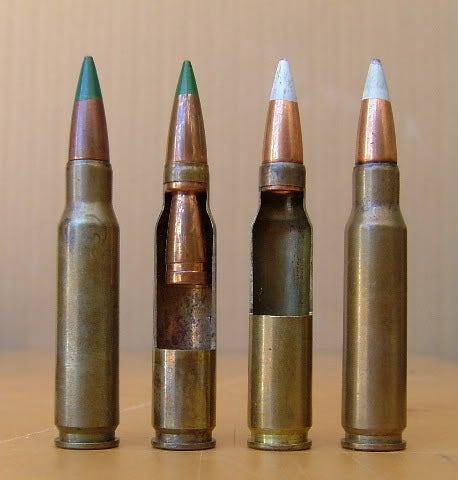Project SALVO’s experiments with multiple projectile ammunition did, surprisingly, result in the production of service ammunition. The 7.62mm M198 Duplex round was an attempt to improve the short-range combat effectiveness of the M14 rifle (so far as this author knows, it was never linked for use in the M60 machine gun – ED: Commenter Bud Harton mentions that it was linked for use in the M60, and this has been confirmed by other sources), but the fundamental limitations of duplex ammunition remained, and it was never successful. Eventually, the improved hit probability rifle would be realized in the .22 caliber AR-15, adopted as the M16 before the Vietnam War.
On the M198 round, cartridge collector Ray Meketa writes:
The lesson of Project SALVO was that nothing works quite as well as a conventional rifle, chambered for a conventional cartridge, firing one bullet at a time. But the lesson was not learned so quickly because following the SALVO II trials in December 1957, Operations Research Office (OCO) recommended the development of a standard length duplex cartridge based on the 7.62mm NATO case.
The cartridge showing the most promise was the T314, loaded with two copper-plated steel bullets in tandem. But, a U.S.Army Infantry Board report released in 1959 concluded that the T314 was not suitable for Army use and did not offer a substantial combat advantage over the standard Ball cartridge (7.62mm NATO M59). Unconvinced, the Army continued development of the cartridge through at least two more iterations culminating in the T314E3. In 1964 it was standardized as 7.62MM BALL-DUPLEX M198.
The M198 entered full scale production with the USMC receiving 4 million rounds for additional field testing. But, as the previous Infantry Board trials had concluded, the cartridge proved to be a disappointment. It did not improve single shot hit probability to the extent hoped for, which after all, was the goal of the duplex concept. There have been reports that some units in Viet Nam were equipped with M198 but, for the most part, production was halted and the entire program abandoned in the early 1970s. Reclassified as Obsolete (OBS), no cartridges remain in military stockpiles.
In retrospect, M198 seems most like an attempt to retrofit existing M14 rifles (a weapon designed around a theory of marksmanship that was becoming more and more glaringly obsolete as time went on) to match the theoretical benefits provided by smaller caliber weapons. While these benefits were eventually realized with the fielding of the M16, why didn’t the duplex ammunition succeed? A single 7.62mm duplex round was, after all, not much heavier than two 5.56mm rounds, while doubling the number of projectiles carried by the M14 rifleman.
Duplex ammunition experiences some major limitations that smaller caliber rounds do not. Being larger caliber rounds, the shooter experiences more recoil during firing. The two 84gr bullets suffer each from their combined recoil impulse as it affects the shooter’s accuracy and speed. In other words, while individual 5.56mm rounds do not throw off and fatigue the shooter as much as individual 7.62mm rounds, duplex 7.62mm rounds will. The ammunition load, too, is not improved. While the duplex shooter fires more projectiles than the single-bullet shooter, no more opportunities are afforded him than the latter, if their ammunition load is the same. In contrast, the small caliber high velocity rifle affords the shooter approximately double the number of opportunities to engage and destroy the enemy, for a given weight.
Finally, though the designers of the duplex rounds made an effort to ensure the twin bullets would follow different trajectories, and though this may have somewhat improved the hit probability of the rifle, the two bullets simply cannot separate very much over normal combat distances. As a result, the suppressive capability of the duplex rifle would have been much, much more similar to the single-bullet firing 7.62mm rifle than to the single-bullet firing 5.56mm rifle with its vastly improved combat load and recoil characteristics. The capability of riflemen with lightweight, small caliber rifles to affect more fire onto an area target more quickly, thereby overwhelming the enemy with superior fire output, is the greatest advantage the small caliber rifle brings to the modern infantryman. The duplex-firing large caliber rifle’s limited dispersion does not afford it as great an advantage in this respect.
 Your Privacy Choices
Your Privacy Choices
